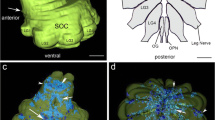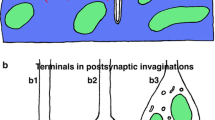Summary
Synaptic terminals on branches of an excitatory motor axon in a spider crab (Hyas areneas) were examined by electron microscopy to determine whether differences in size, structure, and number of synapses could be correlated with differences in transmitter release. Terminals releasing relatively large amounts of transmitter during low frequencies of nerve impulses (“high-output” terminals) had larger synapses, more prominent presynaptic dense bodies (active zones), and fewer synapses per unit length than terminals releasing relatively small amounts of transmitter (“low-output” terminals). Neither the difference in synaptic area, nor the quantitative differences in the active zones, were sufficient in themselves to explain the difference in synaptic efficacy, and it is postulated that a non-linear relationship may exist between structural features of the synapse and release of transmitter by a nerve impulse, and that differences other than those apparent from the ultrastructure could be involved. Greater facilitation at low-output terminals with high frequencies of nerve impulses may be due to greater reserves of “immediately available” transmitter, and to recruitment or activation of more individual synaptic contacts.
Similar content being viewed by others
References
Atwood HL (1973) Crustacean motor units. In: Control of posture and locomotion. Stein RB, Pearson KC, Smith RS, Redford JB (ed). Plenum Publishing Corp. New York, pp 87–104
Atwood HL (1976) Organization and synaptic physiology of crustacean neuromuscular systems. Progr Neurobiol 7:291–391
Atwood HL (1982) Synapses and neurotransmitters. In: The biology of crustacea, Vol 3. Atwood HL, Sandeman DC (ed). Academic Press, New York, pp 105–150
Atwood HL, Bittner GD (1971) Matching of excitatory and inhibitory inputs to crustacean muscle fibers. J Neurophysiol 34:157–170
Atwood HL, Kwan I (1976) Development of synapses in crayfish opener muscle. J Neurobiol 7:289–312
Atwood HL, Morin WA (1970) Neuromuscular and axo-axonal synapses of the crayfish opener muscle. J Ultrastruct Res 32:351–369
Atwood HL, Swenarchuk LE, Gruenwald CR (1975) Longterm synaptic facilitation during sodium accumulation in nerve terminals. Brain Res 100:198–209
Atwood HL, Govind CK, Kwan I (1978). Non-homogeneous excitatory synapses of a crab stomach muscle. J Neurobiol 9:17–28
Bittner GD (1968) Differentiation of nerve terminals in the crayfish opener muscle and its functional significance. J Gen Physiol 51:731–758
Castillo J del, Katz B (1956) Biophysical aspects of neuromuscular transmission. Prog Biophys 6:121–170
DeRosa RA, Govind CK (1978) Transmitter output increases in an identifiable lobster motoneurone with growth of its muscle fibres. Nature (Lond) 273:676–678
Dudel J (1981) The effect of reduced calcium on quantal unit current and release at the crayfish neuromuscular junction. Pflügers Arch 391:35–40
Govind CK, Chiang RG (1979) Correlation between dense bodies and transmitter output at lobster neuromuscular synapses by serial section electron microscopy. Brain Res 161:377–388
Govind CK, Meiss DE (1979) Quantitative comparison of low and high-output neuromuscular synapses from a motoneuron of the lobster (Homarus americanus). Cell Tissue Res 198:455–463
Govind CK, DeRosa RA, Pearce J (1980) Presynaptic dense bars at neuromuscular synapses of the lobster, Homarus americanus. Cell Tissue Res 207:81–88
Govind CK, Meiss DE, Pearce J (1982) Differentiation of identifiable lobster neuromuscular synapses during development. J Neurocytol 11:235–247
Grinnell AD, Herrera AA (1980) Physiological regulation of synaptic effectiveness at frog neuromuscular junctions. J Physiol 307:301–317
Heuser JE (1977) Synaptic vesicle exocytosis revealed in quick-frozen frog neuromuscular junctions treated with 4-aminopyridine and given a single electrical shock. Society for Neuroscience Symposia 2:215–239
Jahromi SS, Atwood HL (1974) Three-dimensional ultrastructure of the crayfish neuromuscular apparatus. J Cell Biol 63:599–613
Kuno M, Turkanis SA, Weakly JN (1971) Correlation between nerve terminal size and transmitter release at the neuromuscular junction of the frog. J Physiol (Lond) 213:545–556
Linder TM (1973) Calcium and facilitation at two classes of crustacean neuromuscular synapses. J Gen Physiol 61:56–73
Ortiz CL, Bracho H (1972) Effect of reduced calcium on excitatory transmitter release at the crayfish neuromuscular junction. Comp Biochem Physiol 41A: 805–812
Parnas H, Dudel J, Parnas I (1982) Neurotransmitter release and its facilitation in crayfish.I. Saturation kinetics of release, and of entry and removal of calcium. Pflügers Arch 393:1–14
Pumplin DW, Reese TS, Llinas R (1981) Are the presynaptic membrane particles the calcium channels? Proc Natl Acad Sci USA 78:7210–7213
Sherman RG (1977) Comparative analysis of an excitatory motor unit in crustaceans. J Comp Physiol 114:91–101
Sherman RG, Atwood HL (1972) Correlated electrophysiological and ultrastructural studies of a crustacean motor unit. J Gen Physiol 59:586–615
Stevens JK, Davis TL, Friedman N, Sterling P (1980) A systematic approach to reconstructing microcircuitry by electron microscopy of serial sections. Brain Res Rev 2:265–293
Tisdale D, Nakajima Y (1976) Fine structure of synaptic vesicles in two types of nerve terminals in crayfish stretch receptor organs: influence of fixation methods. J Comp Neurol 165:369–386
Wernig A (1972) Changes in statistical parameters during facilitation at the crayfish neuromuscular junction. J Physiol (Lond) 244:207–221
Wernig A (1975) Estimates of statistical release parameters from crayfish and frog neuromuscular junctions. J Physiol (Lond) 244:207–221
Wernig A (1976) Localization of active sites in the neuromuscular junction of the frog. Brain Res 118:63–72
Wiens TJ, Atwood HL (1975) Dual inhibitory control in crab muscles. J Comp Physiol 99:211–230
Zucker RS (1973) Changes in the statistics of transmitter release during facilitation. J Physiol (Lond) 229:787–810
Zucker RS (1974) Characteristics of crayfish neuromuscular facilitation and their calcium dependence. J Physiol (Lond) 241:91–110
Zucker RS, Lara-Estrella LO (1979) Is synaptic facilitation caused by presynaptic spike broadening? Nature, Lond 278:57–59
Author information
Authors and Affiliations
Additional information
Supported by a grant from the Natural Sciences and Engineering Research Council of Canada. Mrs. Irene Kwan provided technical assistance in the initial stages of the work, and Ms. Tamara Sosath assisted in preparing data and illustrations.
Dr John K. Stevens provided equipment and advice for three-dimensional reconstruction of nerve terminals; his facility is supported by grants from the Medical Research Council of Canada and from the Natural Sciences and Engineering Research Council of Canada.
Dr C.K. Govind read the manuscript and offered critical comments.
Rights and permissions
About this article
Cite this article
Atwood, H.L., Marin, L. Ultrastructure of synapses with different transmitter-releasing characteristics on motor axon terminals of a crab, Hyas areneas . Cell Tissue Res. 231, 103–115 (1983). https://doi.org/10.1007/BF00215778
Accepted:
Issue Date:
DOI: https://doi.org/10.1007/BF00215778




